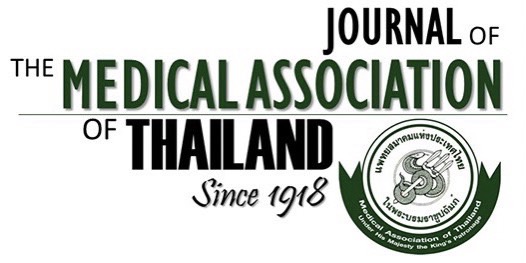The Incidence and Risk Factors of Proximal Vein and Central Vein Stenosis in Acute Arteriovenous Graft and Fistula Thrombosis in Dialysis Patients
Kwanchai Lawanwong MD*, Wiwat Tirapanich MD*, Sopon Jirasiritham MD*, Piyanut Pootrakool MD*, Suthas Horsirimanont MD*, Panuwat Lertsithichai MD**
Affiliation : * Vascular and Transplant Unit, Department of Surgery, Ramathibodi Hospital, Mahidol University, Bangkok, Thailand ** Breast & Endocrine Surgery Unit, Department of Surgery, Ramathibodi Hospital, Mahidol University, Bangkok, Thailand
Background : The incidence and risk factors of the proximal vein and central vein stenosis in Thai hemodialysis patients has
not been well documented.
Objective : 1) To evaluate incidence and risk factors of the proximal vein and central vein stenosis in acute arteriovenous graft
and fistula thrombosis in dialysis patients. 2) To investigate the time to rethrombosis of vascular access after revision and risk
factors for rethrombosis.
Material and Method: Sixty two patients who need the revision of thrombosed hemodialysis access in Vascular and
Transplantation Unit, Ramathibodi Hospital, were included in our study. All patients underwent graft or fistula thrombectomy
with patch angioplasty or jump graft and venogram in order to detect proximal vein and central vein stenosis. In this group,
the treatment is balloon angioplasty. Patient’s demographics data, timing of access creation and dialysis initiation, previous
central venous catheter placement and its patency after the revision were analyzed.
Results : From 62 patients, one was excluded due to contrast allergy. Eighteen patients (30%) had central or proximal vein
stenosis; 11 (61%) were proximal vein stenosis and 7 (39%) were central vein stenosis. Central vein stenosis was found in
11.5% (7/61) of this group of patients and 18% (11/61) for proximal vein stenosis. They were treated with balloon angioplasty
with the technical success rate of 83% (15/18). Rethrombosis was recorded in 37.7% (23/61) at a median time of 2.3 months
(range 1.5 weeks to 11 months) after revision of the access thrombosis. Independent risk factors for rethrombosis were the
presence of central vein and proximal vein stenosis (hazard ratio 3.74), DM (hazard ratio 3.07), and the duration of previous
vascular access (hazard ratio 1.02).
Conclusion : The incidence of central and proximal vein stenosis in acute arteriovenous graft and fistula thrombosis was
30% and had impact to the rethrombosis after access revision.
Keywords : Central vein stenosis, Central vein occlusion, Renal failure, Hemodialysis, Arteriovenous graft, AV fistula



